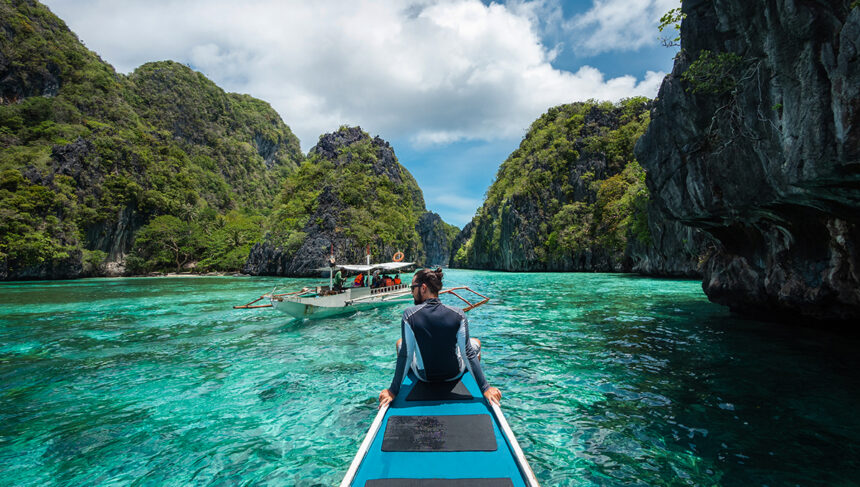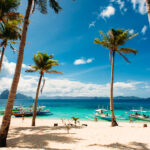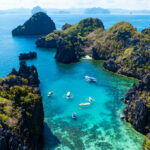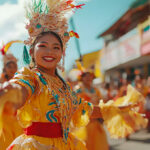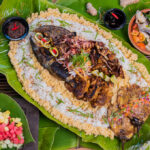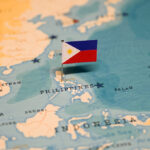Where to go in the Philippines? In the Philippines, among the most lovely locations you will ever visit. This nation boasts tropical woods and islands. Mountains of limestone abound, and the water is so pure it sparkles. The Philippines consists of some 7,000 separate islands. It can be difficult to decide where to begin; there are so many sites to visit. We will cover all you need to know about the Philippines to assist in your travel destination decision.
Where to go in the Philippines?
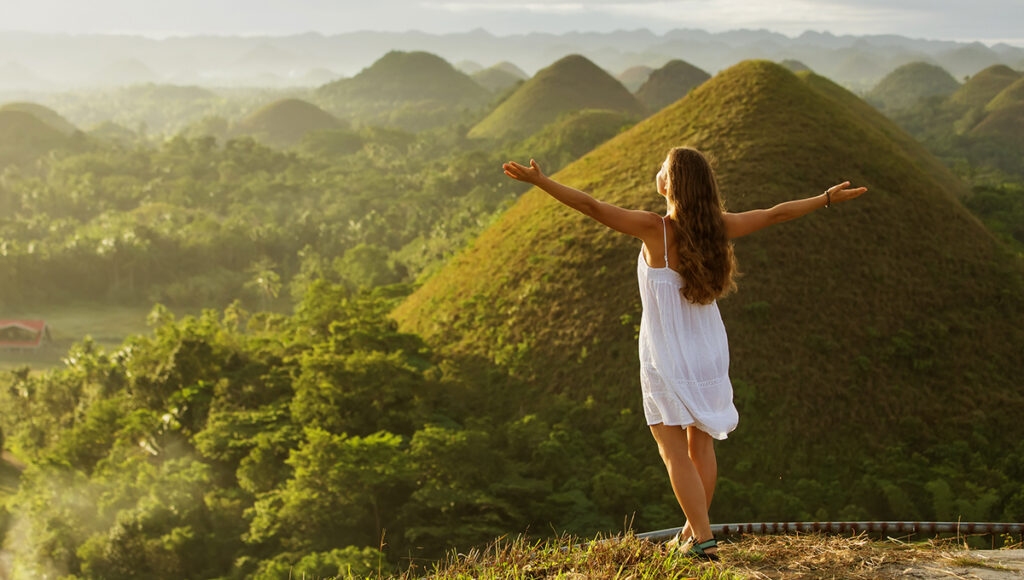
Choosing where to go in the Philippines is the most important (and fun!) part of this Philippines travel plan. These places are some of the most popular tourist spots and may have some of the best things to see. Before adding a place to your schedule, think about what you want to do and how you want to spend your time.
Manila
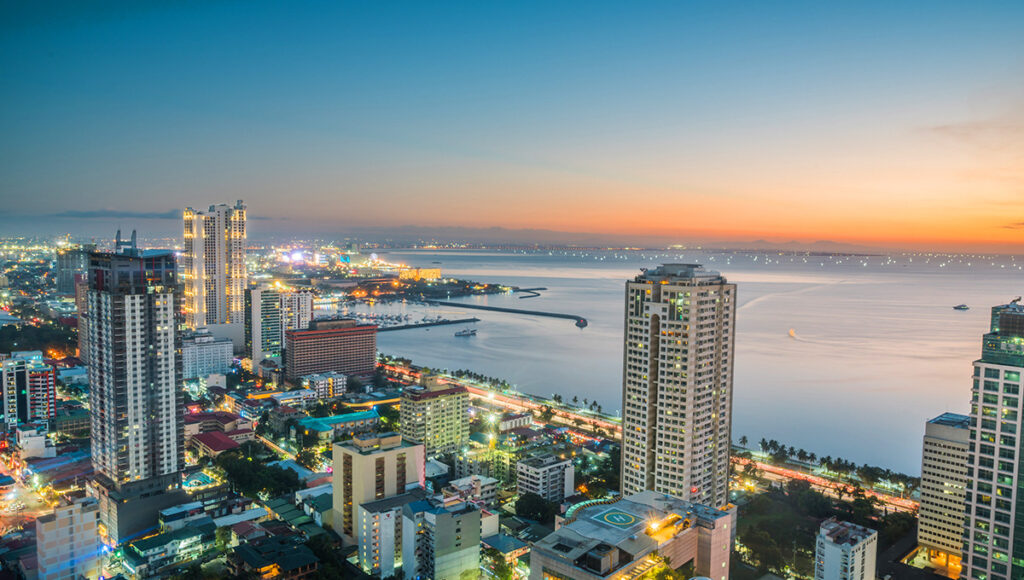
Situated on Manila Bay, Metro Manila, the capital of the Philippines, is comprised of sixteen cities, each has a unique character. Often sporadically maintained yet vibrantly adorned, the ubiquitous pick-up trucks connect the districts and shuttle residents from one point to another.
From ancient Spanish churches to shining high-rise buildings, charming street markets and modern retail centres, historical sites to stylish, vibrant bars and restaurants, the city offers a wonderful combination of the old and the new.
Right in the middle of Manila, in the well-preserved 16th-century walled city of Intramuros, are remnants of the Spanish colonial era. Art galleries, theatres, and a nature park thrive amid ancient cathedrals and dungeons. Early morning exploration of Rizal Park, at the brink of the city walls, is worthwhile when groups of individuals discreetly practice t’ai chi or the ancient martial art of arnis de mano.
Binondo, Metro Manila’s Chinatown, features traditional tea houses and establishments selling Indigenous food, merchandise, and incense, serving as a visual homage to the extensive history of Chinese presence in the Philippines, situated along the northern bank of the Pasig River.
Makati is the commercial head of the capital and presents a striking contrast with its exquisite five-star hotels and shopping malls, including Rockwell and Greenbelt, which, with their quieter paths among manicured gardens, provide cooler havens away from the hectic streets of the city.
Far more traditional is Quiapo, whose streets feature shopkeepers, herbalists, fortune-tellers, and handcraft markets. Malate and Ermita neighbourhoods are popular for their diverse range of restaurants, pubs and cafés, as well as boutiques and neighbourhood art galleries. If you’re exploring these areas, don’t miss the chance to try authentic Filipino dishes served in local eateries, offering a true taste of Manila’s rich culinary heritage.
Whichever sector you visit, you will meet pleasant Filipinos—one of the most appealing features of the city—and casual chats are readily enjoyed since English is generally well-spoken. Though sometimes disregarded as a destination in and of itself, spending a few days to see this vibrant, always-changing city is well worth it.
Palawan
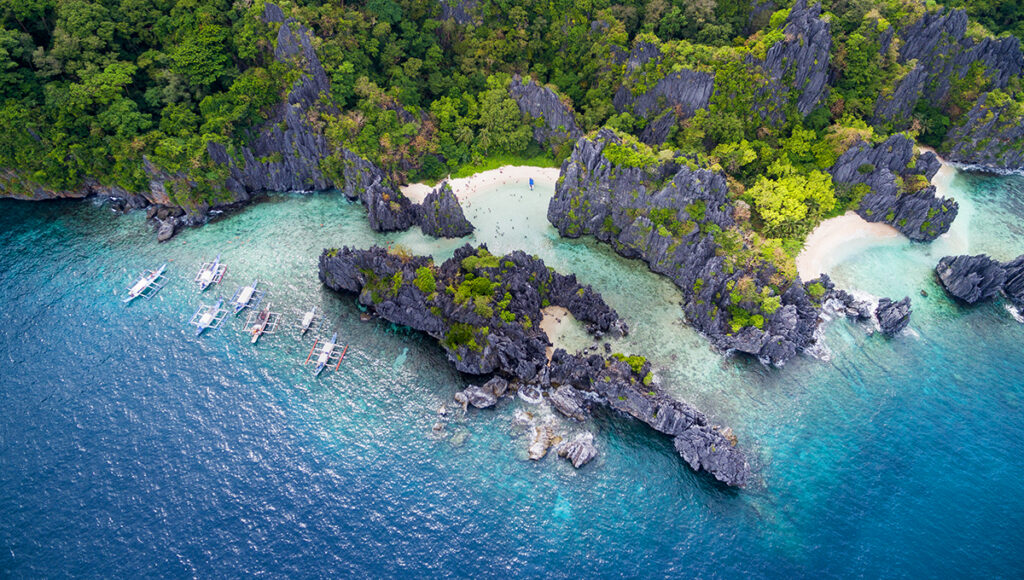
Comprising more than 1,700 islands and islets, Palawan is another island group across the water to the west of the main island of Luzon).
Of the whole archipelago, it is indeed the final natural barrier. Strong ecotourism protects great diving reefs, remote jungles, and tough landscapes above immaculate beaches.
Puerto Princesa
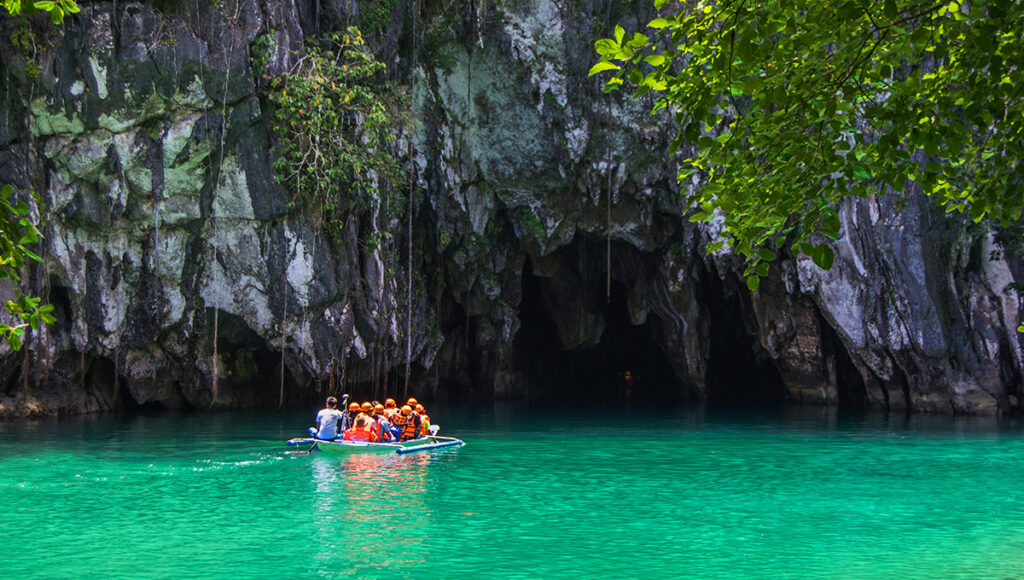
Reached by flight from Cebu and Manila, Puerto Princesa is the capital of the island. Centrally situated, it’s a great starting point for exploring Palawan’s north and south. Set on its island off the coast, Dos Palmas is the premier resort in this region, surrounded by excellent dive spots.
The Underground River, regarded as the longest navigable tunnel globally, is a UNESCO World Heritage Site that provides exceptional opportunities for exploration. It follows a network of pitch-black caverns.
Diving and Snorkelling
The Calamian Islands are renowned for exceptional wreck diving in northern Palawan. Non-divers, however, are drawn to other evocative features, including the limestone cliffs of Coron Island, which climb vertically out of the water above lovely bays. There are plenty of excellent snorkel sites. Both swimmers and divers will find the breathtakingly gorgeous Kayangan volcanic lake a joy encircled by rock walls.
A natural hot spring on the island of Busuanga just outside Coron town is a nice spot to relax after a hectic day and allows you to interact with the area’s residents.
The area presents great island-hopping and chances for solitude and snorkelling for anyone wishing to venture farther afield.
Boracay
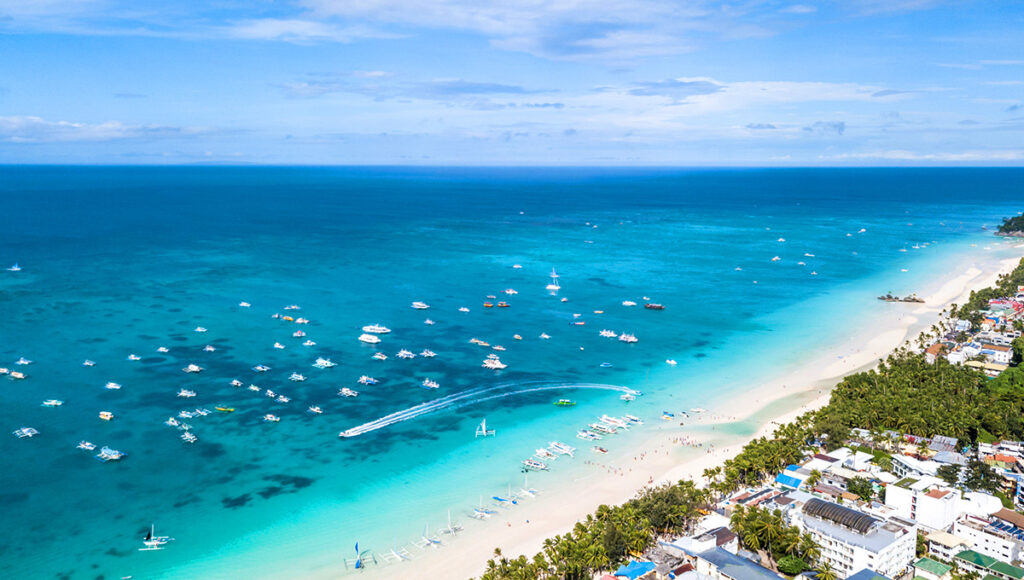
The most famous island in the Philippines is Boracay, which can be reached from Caticlan on Panay’s northern shore.
Popular for its breathtaking 4-kilometre White Beach, it is a weekend trip destination from Manila with a wide range of hotels, resorts, restaurants, and pubs.
Activities
- There are lots of diving and snorkelling possibilities here, but it’s also possible to spend your time here doing nothing very much. You may play golf and unwind in the Mandala spa.
- Islands next to each other.
If you want a change of scenery, you might want to take a boat to one of the surrounding islands, such as Romblon, Carabao, or Tablas.
These islands provide basic accommodation choices if you truly want to escape the crowd for a night or two.
Cebu
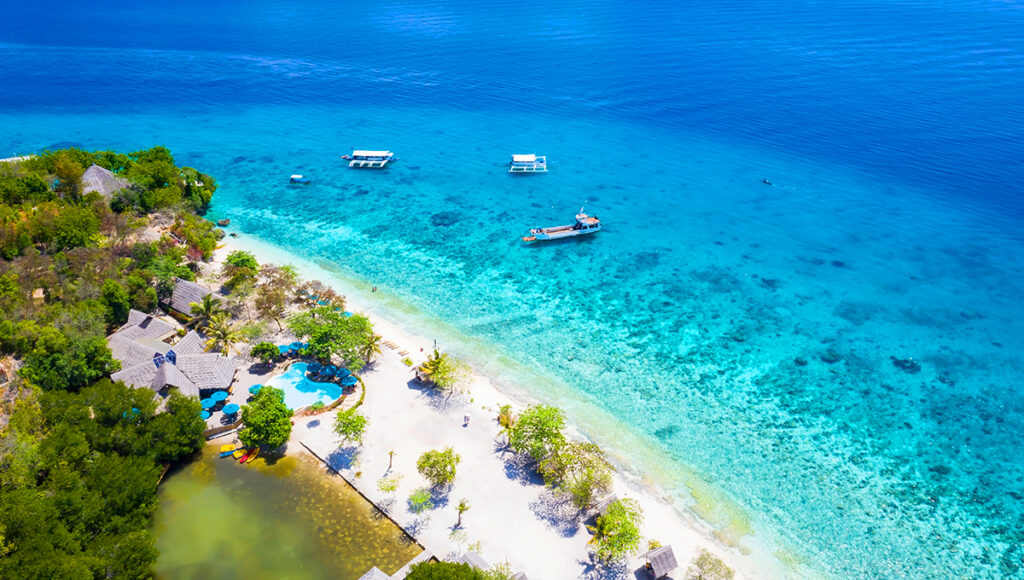
The central Visayas Islands of the Philippines find their heavily inhabited core on the island of Cebu. Usually, moving through here on their way to more isolated beaches. Its beaches are packed, and people abound.
That is not to suggest Cebu lacks any unique attractions. If you know where to look, the island’s historic commercial history with Spain and China is still readily apparent.
Magellan’s Cross is found in the centre of Cebu City at a little chapel by the Basilica del Santo Niño. Said to have pieces of the original one the Portuguese adventurer set here when he arrived in 1521, this big wooden Crossis.
High on a hill just outside the city, you also find a quite exquisite Taoist temple constructed in 1972 by the sizable Chinese population on the island. To reach the temple, where you can marvel at the complex, multi-level construction and expansive view of the city and the far-off islands, you must ascend one of three steep staircases. Mactan, sometimes called Lapu-Lapu, is located just off the island’s eastern shore. Along with a marine life refuge with amazing coral reefs for snorkelling, this little island has some decent beaches. If you’re wondering where to go in the Philippines, this region offers a perfect blend of culture, history, and coastal beauty.
Olango Island Wildlife Sanctuary is easily reachable by a quick trip on a public bangka, a narrow outrigger boat, farther off the coast. The reserve safeguards large seagrass beds, mangrove trees, and a great swath of coralline wetlands. Its prime position for birds travelling the East Asian-Australasian Flyway makes it a frequent rest stop.
Depending on the season, birdwatchers may see roughly 100 species of birds here, equally split between resident species and those just passing through. Search for Asiatic dowitchers, needle-beaked brownish birds that dart across the waving marsh grasses on slender black legs; also look for uncommon Chinese egrets, long-legged, brilliant-white wading birds.
Even in an area renowned for its coral reefs, Malapascua, north of the island, has gained a stellar reputation for diving. The year-round presence of thresher sharks makes divers more likely to see these elegant, long-tailed animals.
Mantas, vivid coral gardens, plenty of fish, many nudibranchs, and enormous numbers of crabs scuttling on the seafloor will also be seen. Other neighbouring wrecks are still sites, and they are now homes to flamefish, scorpionfish, and stingrays.
The island of Cebu is beautiful both in its natural and man-made forms. The Chocolate Chamber offers delicious creations derived from nearby cocoa. Visit for pastries, cakes, hot chocolate, or afternoon tea with a chocolate theme.
El Nido
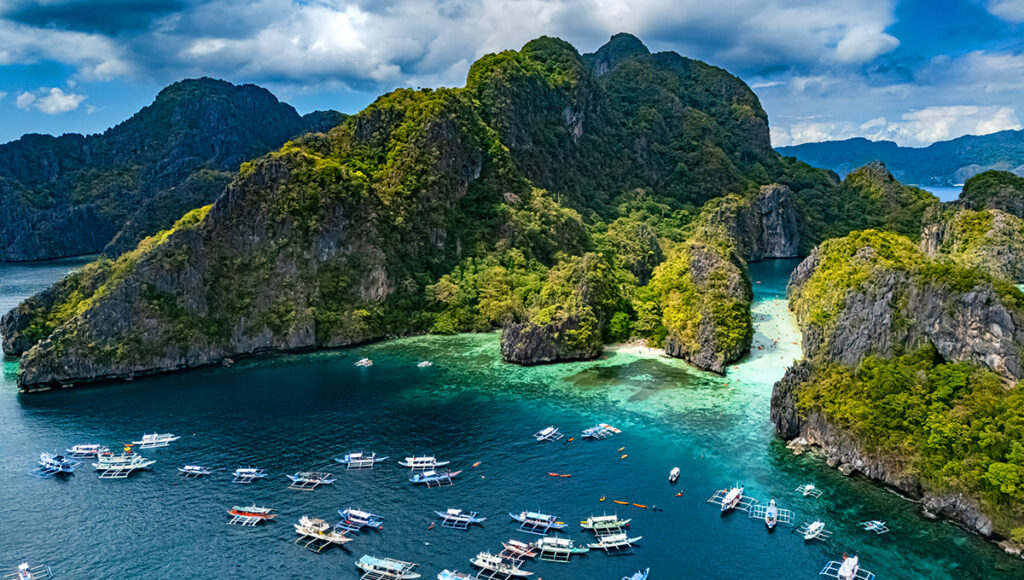
The El Nido area is among the most beautiful and famous locations in the Philippines, thanks to the breathtaking steep limestone cliffs and islands rising out of the water in cathedral-like constructions.
The area was named for the sought-after nests of the edible swiftlet birds, which the local people still gather for bird’s nest soup.
Maintaining swiftlet bird counts
The delicacy in Chinese soup, the fastlet birds’ nests, helped El Nido gain recognition. Sadly, the number of birds dropped over many years since it was impossible to prohibit the gathering of their nests.
Although it is still difficult to enforce in far-off locations, the marine reserve has assisted the government in stopping this practice, allowing nest collecting only once the birds have matured. Consequently, birds have been let to proliferate recently and can still name El Nido their habitat today. For nature lovers planning where to go in the Philippines, El Nido stands out as a must-visit destination for its commitment to conservation and rich biodiversity.
Bacuit Bay
The two El Nido resorts, Miniloc Island and Lagen Island, contain unspoiled forests and animals, lagoons, secret beaches, crystal-clear coves, magnificent reefs and marine life, and Bacuit Bay, home to many of these limestone structures and islands.
The natura of El Nido
Currently a marine reserve, the El Nido area boasts a wide range of habitats, aquatic life, and species. Along with swiftlet birds, the area includes numerous unique species, such as turtles and dugongs (sea cows).
El Nido is home to incredible marine life, including black-tip sharks, limestone, reef corals, and countless of fish and turtles. Diving can be planned at several locations in El Nido to investigate the region’s incredible underwater worlds.
Investigating El Nido
Comprising hundreds of limestone islands claimed to have formed millions of years ago, El Nido provides an amazing setting for appreciation. Only a few islands in the marine reserve are populated; El Nido town is the biggest municipality.
It is a laid-back area against the Marble Cliffs. Talk to the residents, go around the town and surrounding villages, then browse the few boutiques and art stores.
Siquijor
Laid down and welcoming, Siquijor boasts breathtaking beaches and gorgeous surroundings. Renowned for its centuries-old practising healers and sorcerers, this island keeps a feeling of mysticism and beauty.
See down the coast at Coco Grove Beach Resort in Siquijor, Philippines.
The island is somewhat small, so most of the attractions—including the lovely Cambugahay Falls—can be seen in one day, allowing enough time for leisure by the beach. Magical sunsets abound in resident marine parks, which provide great diving or snorkelling opportunities.
Southern Luzon
Explore the Philippines’ military past, paddle to picturesque waterfalls, and take in views of active volcanoes from Southern Luzon.
Manila, the well-known capital of the Philippines’ largest island, Luzon, is located here. But continue south across sugar plantations and hidden communities, and you will also discover a wild scene of jungle-covered mountains, conical volcanoes, large lakes, and little islands bordered by sandy beaches and coral reefs.
Your time here can be spent rafting and canoeing along rivers, trekking among these varied settings, and enjoying views over some of the nation’s most active volcanoes. A visit to a rural coconut farm would allow you to absorb laid-back Filipino culture or tour the ancient military sites scattered around the strategically positioned Corregidor Island. If you’re wondering where to go in the Philippines, this region offers a perfect mix of adventure, history, and cultural immersion.
Things to do in Southern Luzon
Rising from Lake Taal’s quiet, blue waters, this little but active volcano (you might even hear and feel it rumbling) is encircled by verdant vegetation. You can follow paths around the black volcanic shores of the lake and boat trip onto the lake to ascend the volcano when the volcano is not under great alert. But, from Tagaytay town, you can see the volcanic island and the seas around it at any time. Nearby, you may spend a morning touring Taal, a town with 19th-century Spanish and American architecture, including a big Spanish basilica.
Not far off is Magdapio Falls, sometimes called Pagsanjan Falls or Cavinti Falls. Either a short climb from the town of Cavinti or a dugout boat journey, kayaking over the narrow Pagsanjan Gorge before arriving at a natural pool below the three-drop waterfall.
Whether you stay overnight or visit for the day, this operating coconut plantation, two to three hours from Manila, provides a window into rural Filipino life. It got underway in the late 19th century. Along the mild river, you may paddle a traditional bamboo raft, go on nature hikes to see local birdlife, and have lunch beside Labasin Falls, where tables are placed up in the river shallows to keep you cool while you dine.
Corregidor Island, which sits at Manila Bay’s entrance, was strategically used as a reinforced fortress over time. When coastal artillery batteries were employed to defend the harbour and the island from vessel attacks, you can still see their remnants scattered throughout its coast.
Spending a day on the island—reachable by ferry from Manila—you can Visit the historic headquarters of US General MacArthur; in 1941, it became the last stronghold of American resistance during the Japanese invasion of Luzon. Along with mile-long barracks, gun battalions, and the Malinta Tunnel—first employed as a bomb-proof storage bunker then converted into a hospital—you will also witness From where you can enjoy expansive views over Manila Bay, you might also like seeing the Spanish lighthouse.
Best time to visit Southern Luzon
Though tropical storms have been known to strike during this period, the Philippines enjoys reasonably moderate temperatures and dry conditions between December and February. It gets really heated even if it is still dry in March and April. Although the wet season runs from late May through October, the rain is inconsistent, so you may still maximise bright, sunny days combined with less traffic and beautiful surroundings.
Bohol & Panglao Island
East of Cebu, Bohol is an island province with great historical beauty. Located in the southwest of the island, Tagbilaran is the main city, with lovely tree-lined plazas and old stone buildings, including an 18th-century Jesuit-built church.
The province is becoming known for providing among the nicest beaches in the nation. Excellent diving sites abound along the coast, from Panglao, Cabilao, Mahinay, and Lapinpin. Though you may hear of a few fabled stories as to how the hills were created, Bohol is also well-known for its unique landscape, especially the Chocolate Hills—mounds of limestone formations left over from coral reefs during the Ice Age that turn brown throughout the summer. For travellers researching where to go in the Philippines, Bohol stands out as a destination that blends geological marvels with tropical serenity.
Nature enthusiasts will wish to search for the native, tiny Philippine tarsier monkey, one of the tiniest primates on Earth. Numerous waterfalls and caverns, such as the Mag-Aso Falls near Antequera, are scattered around the island. In the native tongue, “Mag-Aso” is “smoke,” which describes the mist the water generates on humid mornings.
To reach Bohol, catch the ferry from Cebu or fly to Tagbilaran Airport from Manila or Cebu. Reached from Bohol by a road bridge, Panglao Island is a nature sanctuary. Our preferred hotels are located here, and day trips from here are simple to plan.
Vigan
Vigan, a UNESCO World Heritage Site, is situated in northern Luzon’s Juan de Salcedo. A Spanish adventurer, Juan de Salcedo, first established it as a commercial town in 1572.
Together with the historical chequerboard street pattern, this is now the best-preserved example of a planned Spanish colonial town in Asia. Vigan is unique from Spanish colonial towns in Latin America as considerable Chinese, Ilocano, and Filipino influences temper its Latin culture.
Celebrated in the third week of January, the Vigan town festival commemorates St Paul the apostle, the patron saint of the town.
Based on eliminating the cotton seeds in yarn preparation, the first week of May is another great time to visit Vigan, where the Viva Vigan Binatbatan Festival is celebrated. The festival features street dance, fashion presentations, and parades.
Dumaguete
Though not a city of great attractions, Dumaguete, sometimes referred to as the “City of the Gentle People,” is a nice spot to unwind and enjoy the lovely architecture and piazzas defining Negros Oriental.
It is also a fantastic base to investigate some stunning beaches and coastal regions, which offer chances for whale and dolphin viewing at particular times of year.
Sagada
Green mountains, large caverns, indigenous culture, and first-rate hiking abound in the highland village of Sagada.
Sagada, tucked away among lush mountain settings, is a laid-back community that draws adventure-seekers to climb, spelunk, and hike. Still, this is also one of the few areas in the Philippines where pre-colonial culture has survived unaltered. Local tradition holds that Sagada was established as a shelter from lowland headhunters, serving as a safe retreat for those escaping the Spanish and then 20th-century rulers.
The town’s remote location and mountainous terrain kept it secluded; today, you may still see the ancient Igorot way of life. The Echo Valley Hanging Coffins and adjacent Burial Cave are maybe the most well-known instances of this culture.
Things to see and do in Sagada
Hiking paths here climb steep hills and pass mist-shrouded woodlands. Rice terraces slink over the valleys, and streams fall down mountain walls with cave openings. With experiences ranging from a tough four-hour caving experience to simple walks on almost level paths, you canr time here as rigorous or as relaxed as you choose. Your specialist can guide your decision-making.
Indigenous culture is vibrant here in every sphere of life, including funeral ceremonies. In Echo Valley, for instance, you can see coffins hanging down the cliff face; some date back hundreds of years, while others are far more recent. And you will find more than one hundred coffins heaped at the entrance of the adjoining burial cave. We may schedule a tour including both sites and a stop at a nearby weaver’s studio; the coffins must be seen with a guide.
Perfect time to go to Sagada
We advise travelling from November to February for the ideal mix of pleasant weather and sunny sky; December might get crowded with tourists.
Batanes
Among the 7,000+ islands that make up the Philippines, the Batanes Islands, located in the extreme north, are different from anywhere else you could discover.
Every one of the three main islands – Batan, Sabtang, and Itbayat has distinct attractions. Batanes boasts lovely undulating hills; its city, Basco, has all the conveniences needed to establish a thriving island population, and its communities are friendly. With just three daily flights from Manila, it is still secluded enough not to have been disturbed by major tourists.
The UNESCO World Heritage Tentative List has even recognized Batanes for its cultural landscape, emphasizing the province’s unique heritage and strong community spirit. The Fundacion de Pacita boutique hotel on the islands provides visitors with amazing views of the Pacific, well-appointed rooms, and a first-rate guest-to-staff ratio for somewhere to stay. The hotel’s foundation is meant to equip the local workforce in the hospitality sector and offer a chance not easily found outside of the big cities. The islands show this community spirit, evident in the local inhabitants often seen cooperating on a little building project. Lunch is a social gathering where everyone eats simultaneously and, even among guests, charity is exchanged.
Visitors seeking to venture further out across to Sabtang Island, a living museum home for the Ivatan people, will board a 30-minute ferry voyage. Little communities hug the coast, still keeping well-preserved traditional houses constructed from locally native rock and grass.
One-meter (three feet) thick walls are constructed, and strong reeds are used to attach grass roofing firmly. For an island frequently in the path of strong storms, the houses must withstand time and appear to have done with some examples still in use today. Here, people live a basic existence; their major source of income is farming and fishing. The island’s protected character has resulted in a UNESCO shortlist, making it a must-visit for those exploring where to go in the Philippines for cultural and historical depth.
Banaue
Three and a half hours from Cauayan airport—the closest for now. To see the amazing rice terraces—some of which go back 2,000 years—both domestic and foreign visitors swarm the town. The area itself boasts five world heritage sites, a rich tribal culture unique to the Ifugao province, and odd features only seen here.
Here, among the locals, they lead a laid-back life with food, family, and farming all playing significant roles. Made homemade smoked rice wine is usually shared over a meal, and riding on top of a jeepney is a daily occurrence. Walking around the town, you often hear individuals listening carefully to country western music left behind during the American occupation. Culture also plays a significant role; many rural communities still have traditional Ifugao homes, farming methods remain unaltered, spiritual ceremonies and superstition still exist; the practice of headhunting does not.
Though fascinating the people are, one cannot escape the reality that visiting or traversing the breathtaking terraces is the main reason one came here. Among the many examples are Batad, sometimes regarded as the highlight due to its scale and amphitheatre-like appearance; Banaue — easily accessible and can be seen from the roadside, Bangaan — a small village nestled among lush, perfectly maintained paddies; and Mayoyao — a little further away and less visited but some say equal to Batad in its magnificence. Another stop on the way to Sagada is Hapao. For those wondering where to go in the Philippines for authentic cultural encounters and scenic mountain trekking, these rice terraces offer an unforgettable escape. There are several ways to trek, from quick walks to several days of exploration; your guide will be on hand to fit each path to your needs.
Though there are many visitors, most are backpackers, and accommodation is still somewhat basic. The Banaue Hotel is the nicest in the area; it has a certain old appeal, comfy rooms, and modest facilities adequate for a few nights’ stay. Although there are also few dining options, the Sanafe Restaurant in the town presents a range of well-prepared local cuisine together with a large wine list.
Planned holidays to show you Philippine locations of interest
Booking aboard a planned tour of Philippine Holiday Packages is the best option if you dislike island hopping on your own or find the planning taxing.
For you, hotels and transportation are all arranged. You have to sit back and unwind. One website where you may view a whole selection of tours by credible tour operators on one page is World Pinoy Flights.
Where in the Philippines would you most like to visit?
Where to go in the Philippines? The above guide suggests where tourists should go, and we recommend more holiday destinations on our site. Not only is it generally safe (all places in the world have crime of some sort), but it also showcases the archipelago’s natural beauty.
Your options are many whether your preferred form of relaxation on a tropical island is adventure or another. Enjoy your search for the top Philippine tourist destinations.


